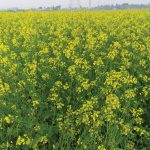Back in the 1980s I spent a lot of time on alfalfa diseases, particularly the verticillium wilt disease problem that was spreading across the Prairies, particularly in southern Alberta. In a few snow-free and cold Decembers in those years, a lot of damage was done to alfalfa, winterkilling entire fields of three-year-old stands. Even white […] Read more

Alfalfa replant disease and related disorders
Whatever the cause, we can realize it's a problem and try to avoid it

Fruit growing on Prairie farms
Part 5 of a series on Prairie farm gardens
Fruit growing on the Canadian Prairies is much easier and more rewarding than most people ever imagine. I am an avid fruit grower on my Alberta acreage, growing everything from plums, pears, grapes, apples and cherries to currants and raspberries. You name it, I am growing it. I am familiar with backyard Prairie gardens all […] Read more

Let’s meet the potato family
Part 4 of a series on Prairie farm gardens
The potato is a member of the solanum or Solanaceae family, made up of thousands of wild and cultivated species that range from deadly nightshade to tomatoes. Commonly cultivated in farm gardens are potatoes, tomatoes, peppers, eggplants and tomatillos. Members of this family also include petunias, lobelias, tobacco and common weeds such as black nightshade […] Read more

Fava beans for Prairie gardens — and fields
Part 3 of a series on Prairie farm gardens
The fava bean (Vicia faba) in Canada is often misunderstood, treated as though it is strictly a southern European or Middle Eastern legume crop. I have even seen the large fava bean type labelled as a Chinese crop. In point of fact, all of Europe grew fava beans. The beans were traditionally classified according to […] Read more

‘Sustainable’ ag systems for Prairie croplands need clearer definition
The word “sustainable” has become one of the most misused words in agricultural information systems. What we have to realize on Canada’s Prairies is that “sustainable” really means farmers maintain the status quo for good, achievable, economic agricultural practices on their cropland. What may be sustainable agricultural systems for Eastern Canada or the north-central United […] Read more

Vegetable crop production on the Prairies
Part 2 of a series on Prairie farm gardens
At the countless farm sites I have visited over almost 50 years from coast to coast in Canada, from Newfoundland to Vancouver Island, I have come across outstanding crop growing innovations and excellent crops as well as abject crop failures. To deal logically with the extensive range of crops, I put them, as described previously, […] Read more

Prairie farm gardens
Growing vegetable and fruit crops in Canada: Part 1 of a series
Garden crops from beans to apples have been a passion of mine from my childhood in Wales. On our small 17-acre Welsh farm in southwest Wales, we grew or raised most of the vegetable food that we ate from potatoes to apples as well as milk, eggs, pork and chickens. The mild climate allowed us […] Read more

Manuring cropland can be misunderstood and overdone
Sources of manure and compost
There are some 60,000 cow-calf farms and 20,000 dairy operations in Canada. Cattle numbers are around 12.5 million with more than 40 per cent of this total in Alberta. Alberta also had 90 per cent of the beef feedlots with lesser numbers in Saskatchewan and Manitoba. There are 14 million hogs at any time in […] Read more

Do you know your cattle?
Notes on Canada’s dairy and beef breeds
The cattle breeds I knew as a teenager are gradually disappearing. When it comes to milk breeds, we have essentially one type of cow, the black and white Holstein, which makes up 94 per cent of Canada’s dairy herds. Holstein is a misnomer in my thinking since in Wales we called them Dutch Friesians. I […] Read more

Mustard production in Western Canada
Canada is one of the world’s largest producers of yellow, oriental and brown mustard types
Yellow mustard, just like ketchup, is an ever-present condiment with almost all conventional fast foods. Who could eat a hot dog in Canada without first lathering the bun with swaths of yellow mustard? Canada, as it turns out, is one of the world’s biggest producers of three kinds of mustard — yellow, oriental and brown […] Read more


